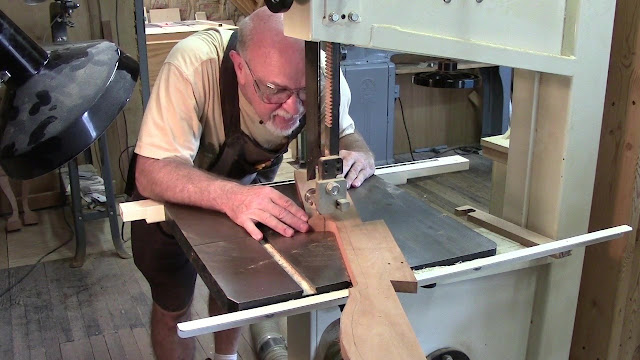Sawing out the dovetail shape
The dovetail fits nice and tight. It will still be glued later.
Cutting out the curves of the blockfront on the bottom piece to prepare for putting a molded edge on it.
Using a router with a cove bit to hog out the majority of the material.
Still need to carve the cove to get the shape that I want on the front. This is the first piece of molding on the front edge, there is another that is below this.
Getting ready to cut the dovetails by marking them out on the sides and bottom. I cut a rabbet on the edge 3/32 deep so that the dovetails on the side will be less than 3/4 inches high. That way the side molding will cover the dovetails completely.
There is a piece on the front edge of the side that has to be removed so that the dovetails will fit.
I also sawed 1/2 inch off of the front edge which I will put back on later to hide the drawer divider dovetails.
Sawing the dovetails on the bottom of the case sides.
Chopping out the pins on the bottom.
Dry fitting the dovetails on the sides and the bottom.
They fit well, so now I am going to make the drawer dividers. I need 3 of them. And they will be dovetailed into the sides.
Cutting a 1/2 inch rabbet for the back in the case sides. You can see I have already cut 1/8 x 3/4 inch dado in the sides for the drawer runners and dividers.
Bandsawing out the curves on the drawer dividers.
Here are the 3 completed drawer dividers. I used a 1/8 inch beading bit to edges on the pieces. I also used a 1/2 inch rabbeting bit to remove 1/8 inch in the center of each piece.
I glued a piece of soft maple to the back of each piece to help keep them flat and add strength.
Now I need to put a dovetail on each end. Using the router and a 14 degree router bit I cut the dovetail on each side. They are 3/8 inch deep.
Using a two router set up and a jig for the routers to follow. I hog out most of the material with a straight bit and then use a 5/8 14-degree router bit to make the 3/8 in deep dovetail socket.
It ends up looking like this. It takes some practise to get it exactly in the middle of the dado groove.
These are about 2 inches long.
Now if I measured correctly, everything should fit together. Surprise it does!
The 1/2 inch that I cut off will be glued on to the front later to cover the dovetails and create a 1/8 inch space for the cockbeading.
That's all for today. Next up is to make a sliding dovetail to attach the top to the sides.


































